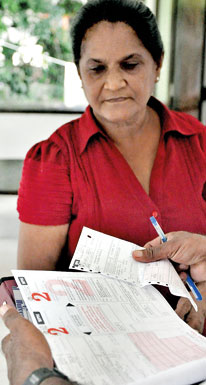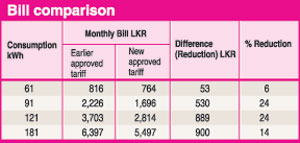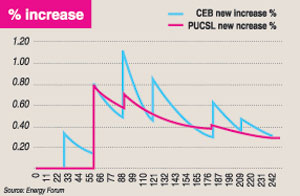News
61-180 Units worst affected as per revised electricity tariff hike
CEB gets its wires crossed over industrial and commercial sectors favouring big over small and medium
The lower middle-income groups that consume between 61 and 180 units of electricity will be the worst affected in Thursday’s fresh revision of electricity tariffs, said Energy Forum Executive Director Asoka Abeygunawardana. “There is no tariff increase for consumers up to 60 units,” said Mr. Abeygunawardana, an electrical engineer by profession.

Old reading, new reading? A housewife in Colombo looks on with trepidation as the metre reader came knocking at her door last morning. Pix by Indika Handuwala
“They will get the same bill as last year.” There will, however, be a marked change in the monthly bills of consumers in the 61-80 units bracket. According to Energy Forum calculations, the monthly bill of a consumer of 61 units of electricity will rise by about 80%, while a consumer of 180 units will have to pay around 40% more on their monthly bill.
Mr. Abeygunawardana explained that they had used different formulae to calculate the percentage increases in the tariffs charged from domestic consumers. “For example, take a consumer of 90 units of electricity,” he elaborated. “Under last week’s tariff revision, he will have to pay Rs 600, at Rs 10 per unit for the first 60 units.”
“Between 60 to 90 units, he will be charged Rs 12 per unit,” he continued. “You have to multiply this by 40% to calculate his fuel adjustment cost, and also add in the fixed cost. So there are three components to his bill—energy, which for him consists of two blocks, fuel adjustment and fixed cost.”
Meanwhile, the PUCSL has not amended the electricity price hikes introduced for the industrial and commercial sectors in April. “These sectors are charged flat tariffs,” Mr. Abeygunawardana said, adding that it was interesting to analyse how government policy has changed.
There are three subdivisions in the industrial sector: Small industries is Industrial Purpose 1, medium is IP2 and large is IP3. “Earlier, all three categories were charged more or less the same,” he pointed out. “With the tariff revision, the rates charged from the IP1 category has increased by 19% while high-end consumers only have to pay around 9% more.”
This inequality leads to other issues, experts point out. For instance, if two companies are marketing the same product, the smaller one cannot compete with the larger entity. “It looks like a policy change to discourage small industries,” reflected Mr. Abeygunawardana.
There are other inequalities. “If you look at the breakup of industrial sector energy consumption, the small industries use only 9% of electricity. So practically speaking, even though the IP1 tariff was increased by a higher percentage, the CEB will not accrue larger revenue.”
The Energy Forum has also found that around 90% of the industrial purpose category comprises small businesses. “In terms of numbers, there are more small industries, but the revenue gained is small,” Mr. Abeygunawardana said. “This means 90% of industries in Sri Lanka will face a high tariff increase.”
Previously, the CEB had imposed a lower tariff on industries and a higher tariff on the commercial sector. This was a reflection of the government’s policy to encourage the production sector over services.

Posters come up in Fort Railway Station: Opposition parties get ready to strike back
Commercial enterprises are categorized as General Purpose 1, GP2, and GP3. “Now, when you compare, the smallest commercial enterprises have got only a 10% increase in tariff, while it’s 19% for the smallest industries. This means the government has made another policy shift to encourage the service sector over production.”
The Energy Forum pointed out that these discriminatory changes were part of the CEB’s original proposal submitted to the PUCSL earlier this year. They were subsequently approved by the regulator and remain in force, despite amendments last week in the domestic rates.
Mr. Abeygunawardana welcomed the PUCSL’s decision to revert to an earlier method of calculating the monthly bill. “The formula proposed in April was the volume differentiated tariff which wasn’t appropriate for calculating domestic consumption,” he said.
The volume differentiated tariff method divided consumers into blocks, with sharp jumps in the monthly bill from one to another. The PUCSL has brought back the incremental progressive block method under which there is a gradual growth in the amount billed.
“What happened was similar to the Z-score issue,” Mr. Abeygunawardana said. “The original decision of changing from the previous tariff method to a new one created a mess.” The new tariffs are backdated April 20, and will come into force on May 20. Up to yesterday, meter readers were issuing bills based on last year’s rates.
CEB officials said that they will now have to calculate the new rates and print them out for meter readers. “The calculation will not take time,” a senior official said. “But printing between 5,000 and 6,000 copies and getting them across to all the meter readers will take a little time.”
Commenting on how revenues have been affected by the delay in implementing the tariff revision, he laughed, “You are talking about annual revenue. Half the year is gone now. Only half the revenue will come!”
 |
 |
Follow @timesonlinelk
comments powered by Disqus

